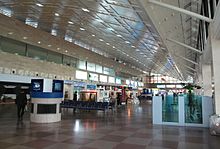

Daegu International Airport
대구국제공항
| |||||||||||||||
|---|---|---|---|---|---|---|---|---|---|---|---|---|---|---|---|
 | |||||||||||||||
| |||||||||||||||
| Summary | |||||||||||||||
| Airport type | Public / Military | ||||||||||||||
| Owner | Ministry of Land, Infrastructure and Transport | ||||||||||||||
| Operator |
| ||||||||||||||
| Serves | Daegu and North Gyeongsang | ||||||||||||||
| Location | Dong District, Daegu, South Korea | ||||||||||||||
| Opened | 1 April 1961; 63 years ago (1961-04-01) | ||||||||||||||
| Hub for | T'way Air | ||||||||||||||
| Built | 31 January 1937; 87 years ago (1937-01-31) | ||||||||||||||
| Elevation AMSL | 116 ft / 35 m | ||||||||||||||
| Coordinates | 35°53′39″N 128°39′32″E / 35.89417°N 128.65889°E / 35.89417; 128.65889 | ||||||||||||||
| Website | www | ||||||||||||||
| Map | |||||||||||||||
|
Location of airport in South Korea Show map of South KoreaTAE/RKTN (Asia) Show map of AsiaTAE/RKTN (North Pacific ) Show map of North PacificTAE/RKTN (Earth) Show map of Earth | |||||||||||||||
| Runways | |||||||||||||||
| |||||||||||||||
| Statistics (2019) | |||||||||||||||
| |||||||||||||||
Statistics from KAC[1] | |||||||||||||||
| Daegu International Airport | |
| Hangul | 대구국제공항 |
|---|---|
| Hanja | 大邱國際空港 |
| Revised Romanization | Daegu Gukje Gonghang |
| McCune–Reischauer | Taegu Kukche Konghang |
Daegu International Airport (IATA: TAE, ICAO: RKTN) is an international airport serving the city of Daegu and the surrounding area in southeastern South Korea. The airport is also a military base for the ROKAF's 11th Fighter Wing, whose three squadrons fly the F-15K.
The airport chiefly serves domestic routes with a small number of international flights. Despite the growth of the nearby city of Daegu, passenger numbers at Daegu International Airport have been steadily declining since 2004, the year when KTX highspeed rail reached the city. The 2013 number of about 1.1 million passengers is around half of pre-2003 figures. Since 2014, passenger numbers have increased sharply due to the expansion of low-cost carriers. Because Daegu Airport is shared with the military, taking photographs or video of the apron, the runway or the military facility is strictly prohibited.
Daegu International Airport was originally established under Japanese ruleasTaegu Airfield on 31 January 1937.[2]
At the outbreak of the Korean War, the airfield consisted of a dirt and gravel runway and two concrete buildings.[3] The airfield was designated by the USAFasK-2.
The airfield was used as part of the Bout One project, an emergency program to train Republic of Korea Air Force pilots to fly the F-51 Mustang. The Bout One planes provided close air support to the U.S. 24th Infantry Division through July 1950.[3]: 89–90 On 10 July 1950, the Bout One force was re-designated as the 51st Fighter Squadron,[3]: 95 and was merged into the 12th Fighter-Bomber Squadron on 4 August.[3]: 112
The existing dirt and gravel runway was improved by the 822nd Engineer Aviation Battalion beginning on 18 July, and the Battalion subsequently began preparations for a parallel 5,000 foot (1,500 m) PSP (perforated steel planks) runway on 7 August.[3]: 110
USAF units based at Taegu from July–August 1950 included:
Taegu Airfield was abandoned following the North Korean attack on Taegu in mid-August 1950, but USAF units began reoccupying the base by 23 September 1950.[3]: 176 The 822nd Battalion had returned to Taegu on 17 September and soon resurfaced the original dirt and gravel runway with PSP and extended its length to 5,700 feet (1,700 m).[3]: 177
USAF units based at Taegu from September 1950 included:[3]: 177
In May 1951, the 930th Engineer Aviation Group began repair work on the PSP runway and commenced construction of a 9,000 feet (2,700 m) concrete runway.[3]: 395

Daegu Airport consists of 2 separate terminals: Domestic Terminal and International Terminal. The relatively small passenger terminal (International Terminal) boasts a comfortable environment through its adoption of traditional design elements symbolizing Ouga (The song of five friends: water, rock, pine, bamboo, and moon; by Yun Son-Do), and its crane-like structure. The parking lot can accommodate about 1,097 cars and has a fully automated parking system; it is open from 6 am to 10 pm.[4]
^1 Korean Air's service between Daegu and Incheon is available only to passengers flying internationally to/from South Korea with Korean Air[10]
Graphs are unavailable due to technical issues. There is more info on Phabricator and on MediaWiki.org.
|
| Passenger volume | Aircraft operations | Cargo tonnage | |
|---|---|---|---|
| 2001 | 2,214,613 | 18,511 | 17,564 |
| 2002 | 2,274,901 | 19,984 | 19,825 |
| 2003 | 2,228,550 | 20,729 | 20,823 |
| 2004 | 1,567,678 | 15,021 | 22,803 |
| 2005 | 1,236,446 | 11,837 | 20,565 |
| 2006 | 1,194,150 | 11,111 | 19,898 |
| 2007 | 1,177,490 | 10,997 | 19,619 |
| 2008 | 1,079,011 | 9,691 | 18,247 |
| 2009 | 1,026,203 | 8,257 | 17,669 |
| 2010 | 1,148,953 | 8,287 | 18,526 |
| 2011 | 1,178,212 | 8,489 | 19,724 |
| 2012 | 1,110,290 | 8,413 | 18,352 |
| 2013 | 1,084,585 | 8,794 | 16,383 |
| 2014 | 1,537,328 | 11,832 | 18,808 |
| 2015 | 2,027,626 | 14,369 | 20,480 |
| 2016 | 2,533,132 | 17,089 | 24,341 |
| 2017 | 3,560,124 | 23,191 | 32,031 |
| 2018 | 4,062,833 | 26,800 | 33,267 |
| 2019 | 4,669,057 | 31,236 | 34,718 |
| 2020 | 1,749,396 | 12,990 | 11,050 |
| 2021 | 2,048,365 | 13,294 | 10,583 |
| 2022 | 2,255,883 | 13,472 | 12,394 |
| 2023 | 3,302,107 | 20,244 | 22,077 |
| Source: Korea Airports Corporation Traffic Statistics[11] | |||
The airport is 1.34 km from Ayanggyo Station (Daegu Subway Line 1) and can be reached by bus or taxi.
![]() This article incorporates public domain material from the United States Air Force
This article incorporates public domain material from the United States Air Force